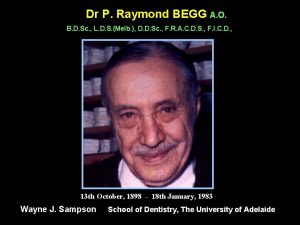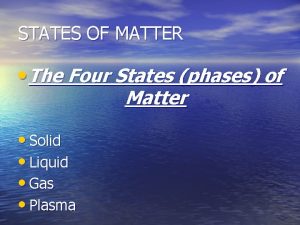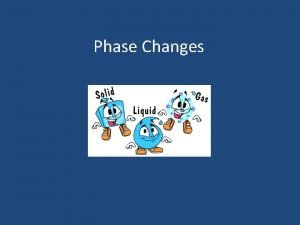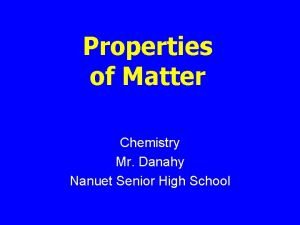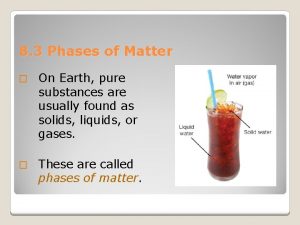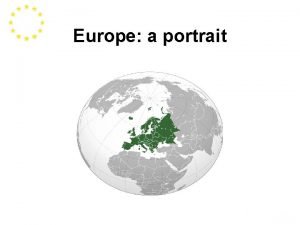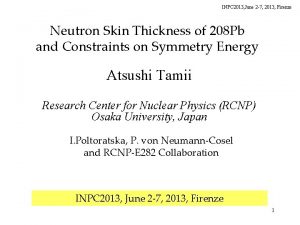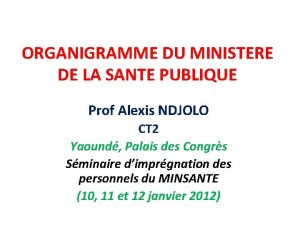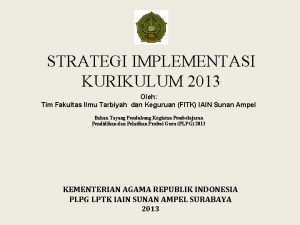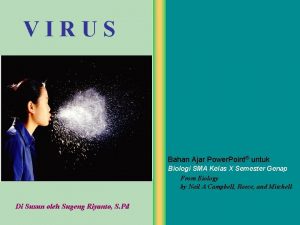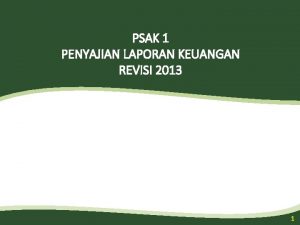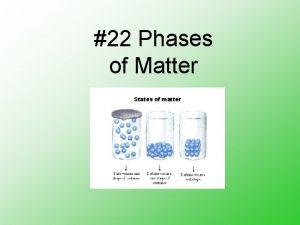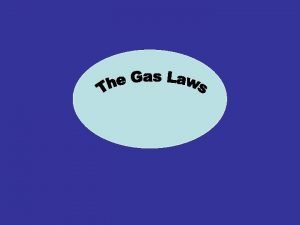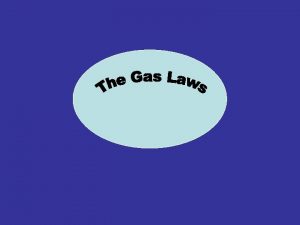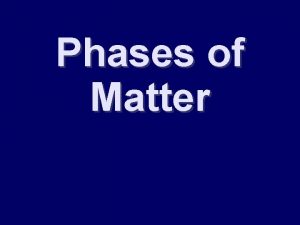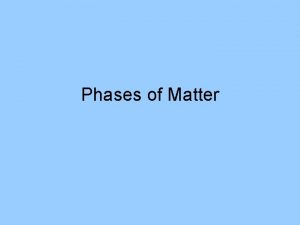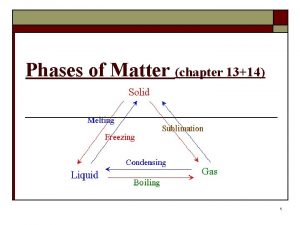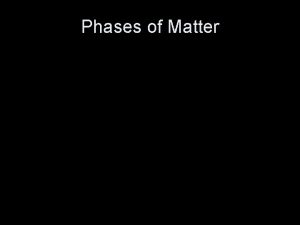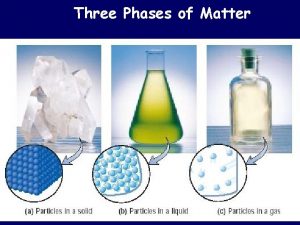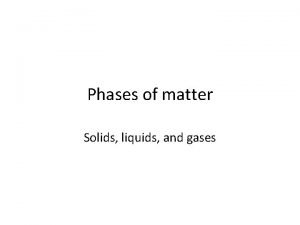2013 S Coates Phases of Matter Phases of



















































- Slides: 51

© 2013 S. Coates

Phases of Matter

Phases of Matter • Solids: Particles are tightly packed together and DO NOT move past each other. They vibrate in place. © 2013 S. Coates

Phases of Matter • Examples of Solids: © 2013 S. Coates

Phases of Matter • Solids have a definite SHAPE • Solids have a definite VOLUME Example—Marble Shape = Sphere Volume = can be found using water displacement © 2013 S. Coates

Phases of Matter • Liquids: Particles are still tightly packed together and they SLIDE move past each other. © 2013 S. Coates

Phases of Matter • Examples of Liquids: © 2013 S. Coates

Phases of Matter • Liquids DO NOT have a definite SHAPE, they take the shape of their container. • Liquids have a definite VOLUME Example—Orange Juice Shape = None, it takes the shape of the glass. Volume = can be found using a beaker or graduated cylinder. © 2013 S. Coates

Phases of Matter • Gases: Particles are not tightly packed together, and have so much energy they slip past each other quickly. © 2013 S. Coates

Phases of Matter • Examples of Gases: © 2013 S. Coates

Phases of Matter • Gases DO NOT have a definite SHAPE • Gases DO NOT have a definite VOLUME Example—Smoke Shape = Not definite. Volume = Not definite. Gases are usually always expanding. © 2013 S. Coates

Phases of Matter • Plasma: Particles are moving so quickly it is hard to see what they are actually doing. © 2013 S. Coates

Phases of Matter • Examples of Plasma on Earth: © 2013 S. Coates

Phases of Matter • Two “laws” about gases… 1. Charles’ Law T= V • Volume (of gas) and Temperature • When temperature goes up, volume goes up • When temperature goes down, volume goes down © 2013 S. Coates

Gas + Heat = Expansion! http: //www. usaballoon. com/fly. htm © 2013 S. Coates http: //www. coloradoguy. com/balloona-vista/hotairballoons-buenavista-co. htm

Phases of Matter • Two “laws” about gases… 2. Boyles’ Law V= P • Volume (of gas) and Pressure • When pressure goes up, volume goes down • When pressure goes down, volume goes up © 2013 S. Coates

The amount of water pressure determines the size of bubbles in the water. © 2013 S. http: //www. gettyimages. com/detail/91300130/Photographers-Choice Coates http: //gallery. photo. net/photo/9734756 -lg. jpg

Low pressure Large Volume High pressure Small Volume © 2013 S. Coates

Bose-Einstein Condensate • Exist at extremely cold temperatures (around absolute zero or -460 o. F) • Particles are super unexcited • Particles lock or “clump” together so firmly that they move as a single unit • Definite shape and volume (? )

Solid • Particles are tightly compact • Very Dense (thick) • Particles vibrate without the ability to move freely • Definite (exact) shape and volume • Solid Animation

Phases of Matter ADDED • Is ENERGY being ADDED or TAKEN AWAY in this phase change: The added energy has caused the chocolate particles to speed up. Before they were vibrating in place, now they are moving fast enough to slip past one another. Solid Liquid © 2013 S. Coates

Phases of Matter • Is ENERGY being ADDED or TAKEN AWAY in this phase change: ADDED The added energy has caused the water particles to speed up. Before they were moving fast enough to slip past one another, now they have enough energy to break away from one another and expand. Liquid Gas © 2013 S. Coates

Phases of Matter • Is ENERGY being ADDED or TAKEN AWAY in this phase change: Taken Away Taking away energy from a rain drop slows the water molecules down so that they no longer slide past one another. Liquid Solid © 2013 S. Coates

Matter • Anything that has mass and takes up space (volume) – Examples: • • • A brick(a solid) has mass and takes up space A desk has mass and takes up space A pencil has mass and takes up space Air (a gas) has mass and takes up space Gasoline (a liquid) has mass and takes up space All of the above examples are considered matter because they have mass and take up space. Can you think of anything that would not be considered matter?

Matter • Yes! Fire is NOT an example of matter

WHY Fire is NOT an example of matter When a gas is heated by many thousands of degrees, the individual atoms collide with enough violence to knock electrons free, resulting in a collection of positively charged ions and free, negatively charged electrons. The gas is said to be ionized, and when a sizable number of the atoms become ionized, the gas is called a plasma. Photograph: The interaction of the Sun's magnetic field with the motions of the plasma in and around the Sun … NASA Fire while hot does not ionize with enough particles under pressure to be considered a traditional plasma or for that matter… MATTER; it is considered by most scientists to be a chemical reaction.

Physical Properties of Matter • Any property of matter that can be observed or measured without changing the identity of the matter • Examples temperature color shape taste state/phase density D=m V

Phases of Matter • Physical Changes: only the phase changes, the substance does not. • Physical changes usually change the size or shape of the substance. • Examples of physical changes include: © 2013 S. Coates

Chemical Properties of Matter • any property of matter that describes a substance based on its ability to change into a new substance • Examples flammability reactivity with vinegar reactivity with oxygen Iron + Oxygen Iron oxide (rust) 2 Fe + 3 O 2 Fe 2 O 3

Phases of Matter • Chemical Changes: changes that create NEW materials. • The original materials are changed into something different. • Examples of chemical changes include: © 2013 S. Coates

Chemical or Physical Property? 1. Paper is white _______ Property 2. 3. Boiling point of H 2 O is 100 o. C _________ Property Zinc reacts with hydrochloric acid and creates hydrogen gas _________ Property 4. Nitrogen does not burn _________ Property 5. Sulfur smells like rotten eggs _________ Property

Comparing Physical and Chemical Properties Substance/Matter Physical Property Chemical Property Helium Less dense than air Nonflammable Wood Grainy texture Flammable Baking soda White powder Reacts with vinegar to produce bubbles Powdered sugar White powder Does not react with vinegar Rubbing alcohol Clear liquid Flammable Red food coloring Red color Reacts with bleach and loses color Iron Malleable Reacts with oxygen

Physical Properties of Matter • Any property of matter that can be observed or measured without changing the identity of the matter • Examples temperature color shape taste D=m state/phase V density

Density • a measure of the amount of matter present in a given volume of a substance m • typically expressed in the following units: – grams per cubic centimeter (g/cm 3) for solids – grams per milliliter (g/ml) for liquids D V • can change as temperature and pressure change • does not depend on how much of a substance you Which do you think have (intrinsic property) – in other words, the is more dense? Why? density of a gold bar would be the same as the density of a gold flake .

Phases of Matter • Physical Changes: only the phase changes, the substance does not. • Physical changes usually change the size or shape of the substance. • Examples of physical changes include: • And Phase Changes… © 2013 S. Coates

Why do you think Bose-Einstein and Changes in States plasma are not equally distanced from the(Physical other three. Changes) states of matter? Plasma Ionization Disposition Recombination Vaporization (Evaporation/Boiling) Liquid Melting Solid Gas Condensation Freezing Sublimation Bose-Einstein All changes in state require a change in energy


Chemical Properties of Matter • any property of matter that describes a substance based on its ability to change into a new substance • Examples flammability reactivity with vinegar reactivity with oxygen Iron + Oxygen Iron oxide (rust) 2 Fe + 3 O 2 Fe 2 O 3

Chemical or Physical Change? 1. Bending a Paper Clip Physical Change 2. Baking a cake Chemical Change 3. The sublimation of carbon dioxide Physical Change 4. Crushing an aluminum can Physical Change 5. Vinegar and baking soda combining to create salt and water Chemical Change

EXOTHERMIC Exothermic- the word describes a process that releases energy in the form of heat. Forming a chemical bond releases energy and therefore is an exothermic process. Exothermic reactions usually feel hot because it is giving heat to you. ENDOTHERMIC Endothermic - a process or reaction that absorbs energy in the form of heat. Breaking a chemical bond requires energy and therefore is Endothermic reactions usually feel cold because it is taking heat away from you.


Law of Conservation of Matter • Matter cannot be created or destroyed. Either it is changed physically or chemical changes allow for atoms to break and establish new bonds creating different substances with the same molecules.

Mass vs. Weight Mass • a measure of how much matter an object is made of • does not change, regardless of where something or someone is Mass = 59 kg Weight = 579 N Weight • the force of gravity on an object • equal to the mass of the body times the local acceleration of gravity Why do you think the person’s weight is less on the moon? Mass = 59 kg Weight = 96 N http: //www. exploratorium. edu/ronh/weight/index. html

5 Physical States of Matter • Bose-Einstein • Solid • Liquid • Gas • Plasma

Phases of Matter • Matter can change phases permanently or temporarily. • Temporary changes are called PHYSICAL changes. • Permanent changes are called CHEMICAL changes. © 2013 S. Coates

Phases of Matter • Is this a chemical change, or a physical change? Chemical The bottle rocket is being turned into a new substance. © 2013 S. Coates

Phases of Matter • Is this a chemical change, or a physical change? Physical The ingredients for ice cream are mixed and cooled in a machine. The ice cream has the same chemical structure when it was a liquid as it does when it is a solid. © 2013 S. Coates

Phases of Matter • Is this a chemical change, or a physical change? Chemical The egg has been cooked, and that has changed it into a new substance. © 2013 S. Coates

Phases of Matter • Let’s summarize: Phase Motion of Particles Speed of Particles Solid Particles vibrate in place Slow Liquid Particles are close, but can slide past one another Medium Gas Particles are constantly expanding Fast Plasma Unknown Faster than we can see © 2013 S. Coates

Phases of Matter • Let’s summarize: Phase Solid Definite Shape? YES Definite Volume? YES Liquid NO YES Gas NO NO Plasma © 2013 S. Coates

Self-Check YES 1. I can describe how atoms move in a solid, liquid, and gas 2. I can describe the speed/energy of the atoms in a solid, liquid, and gas. 3. I can explain how the distance between atoms is related to the states of matter. 4. I can indicate whether or not each state of matter has a definite shape and volume 5. I can explain how the volume of a gas is changed by a change in pressure. 6. I can explain how the volume of a gas is changed by a change in temperature. © 2013 S. Coates NO
 Edgewise begg appliance
Edgewise begg appliance Vierkante meter
Vierkante meter Concept map of matter solid liquid and gas
Concept map of matter solid liquid and gas Four phases of matter
Four phases of matter Why isn't it a good idea to classify matter by its phases
Why isn't it a good idea to classify matter by its phases 4 phases of matter
4 phases of matter Phases of matter foldable
Phases of matter foldable 5 phases of matter
5 phases of matter Phases of matter
Phases of matter 3 phases of matter
3 phases of matter Telecephalon
Telecephalon Chapter 2 section 1 classifying matter answer key
Chapter 2 section 1 classifying matter answer key Energy naturally flows from warmer matter to cooler matter.
Energy naturally flows from warmer matter to cooler matter. Classification of matter section 1 composition of matter
Classification of matter section 1 composition of matter Composition of matter section 1
Composition of matter section 1 Primary taste cortex
Primary taste cortex Grey matter
Grey matter Gray matter and white matter
Gray matter and white matter Section 1 composition of matter
Section 1 composition of matter 326 os kormányrendelet 2013
326 os kormányrendelet 2013 Ph 2013
Ph 2013 What is nipp
What is nipp Kertas kerja usaha salon berdikari
Kertas kerja usaha salon berdikari Odden and rochat
Odden and rochat Eu gdp 2013
Eu gdp 2013 Css 2013
Css 2013 2013 pearson education inc
2013 pearson education inc Pusbangtendik 2013
Pusbangtendik 2013 Inpc 2013
Inpc 2013 Iso/iec jtc 1/sc 27/wg 1 27001:2013
Iso/iec jtc 1/sc 27/wg 1 27001:2013 Word standard toolbar
Word standard toolbar Organigramme direction régionale santé maroc
Organigramme direction régionale santé maroc Visual c 2013
Visual c 2013 Pakistan education statistics 2013
Pakistan education statistics 2013 Ley 139-13 de las fuerzas armadas
Ley 139-13 de las fuerzas armadas Strategi implementasi kurikulum 2013
Strategi implementasi kurikulum 2013 Bimbingan konseling dalam kurikulum 2013
Bimbingan konseling dalam kurikulum 2013 Materi virus kelas 10 ppt
Materi virus kelas 10 ppt Gred spm
Gred spm 2013 fen bilimleri öğretim programı
2013 fen bilimleri öğretim programı Psak 1 revisi 2013
Psak 1 revisi 2013 Decreto 8145/2013
Decreto 8145/2013 Rpp keterampilan membaca
Rpp keterampilan membaca Iso/iec jtc 1/sc 27/wg 1 27001:2013
Iso/iec jtc 1/sc 27/wg 1 27001:2013 Instrumen penilaian rpp kurikulum 2013
Instrumen penilaian rpp kurikulum 2013 Contoh asesmen portofolio
Contoh asesmen portofolio 2013 pearson education inc
2013 pearson education inc 2022-2013
2022-2013 Tema iht kurikulum 2013
Tema iht kurikulum 2013 Matematikos vbe taskai i balus
Matematikos vbe taskai i balus What is ghag
What is ghag Niveluri de studii
Niveluri de studii
